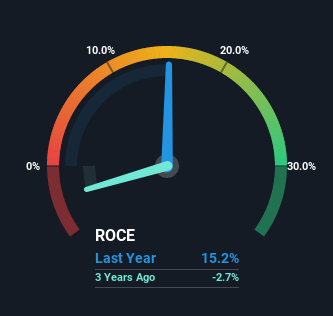- United States
- /
- Marine and Shipping
- /
- NasdaqCM:GLBS
Returns On Capital Are Showing Encouraging Signs At Globus Maritime (NASDAQ:GLBS)

To find a multi-bagger stock, what are the underlying trends we should look for in a business? One common approach is to try and find a company with returns on capital employed (ROCE) that are increasing, in conjunction with a growing amount of capital employed. Ultimately, this demonstrates that it's a business that is reinvesting profits at increasing rates of return. Speaking of which, we noticed some great changes in Globus Maritime's (NASDAQ:GLBS) returns on capital, so let's have a look.
What is Return On Capital Employed (ROCE)?
For those that aren't sure what ROCE is, it measures the amount of pre-tax profits a company can generate from the capital employed in its business. To calculate this metric for Globus Maritime, this is the formula:
Return on Capital Employed = Earnings Before Interest and Tax (EBIT) ÷ (Total Assets - Current Liabilities)
0.15 = US$28m ÷ (US$196m - US$11m) (Based on the trailing twelve months to March 2022).
So, Globus Maritime has an ROCE of 15%. In absolute terms, that's a pretty normal return, and it's somewhat close to the Shipping industry average of 18%.
Check out our latest analysis for Globus Maritime

In the above chart we have measured Globus Maritime's prior ROCE against its prior performance, but the future is arguably more important. If you'd like, you can check out the forecasts from the analysts covering Globus Maritime here for free.
What Does the ROCE Trend For Globus Maritime Tell Us?
Globus Maritime has recently broken into profitability so their prior investments seem to be paying off. The company was generating losses five years ago, but now it's earning 15% which is a sight for sore eyes. In addition to that, Globus Maritime is employing 166% more capital than previously which is expected of a company that's trying to break into profitability. This can tell us that the company has plenty of reinvestment opportunities that are able to generate higher returns.
On a related note, the company's ratio of current liabilities to total assets has decreased to 5.7%, which basically reduces it's funding from the likes of short-term creditors or suppliers. So this improvement in ROCE has come from the business' underlying economics, which is great to see.
The Bottom Line
To the delight of most shareholders, Globus Maritime has now broken into profitability. Although the company may be facing some issues elsewhere since the stock has plunged 100% in the last five years. In any case, we believe the economic trends of this company are positive and looking into the stock further could prove rewarding.
Since virtually every company faces some risks, it's worth knowing what they are, and we've spotted 4 warning signs for Globus Maritime (of which 2 are a bit unpleasant!) that you should know about.
While Globus Maritime isn't earning the highest return, check out this free list of companies that are earning high returns on equity with solid balance sheets.
New: Manage All Your Stock Portfolios in One Place
We've created the ultimate portfolio companion for stock investors, and it's free.
• Connect an unlimited number of Portfolios and see your total in one currency
• Be alerted to new Warning Signs or Risks via email or mobile
• Track the Fair Value of your stocks
Have feedback on this article? Concerned about the content? Get in touch with us directly. Alternatively, email editorial-team (at) simplywallst.com.
This article by Simply Wall St is general in nature. We provide commentary based on historical data and analyst forecasts only using an unbiased methodology and our articles are not intended to be financial advice. It does not constitute a recommendation to buy or sell any stock, and does not take account of your objectives, or your financial situation. We aim to bring you long-term focused analysis driven by fundamental data. Note that our analysis may not factor in the latest price-sensitive company announcements or qualitative material. Simply Wall St has no position in any stocks mentioned.
About NasdaqCM:GLBS
Globus Maritime
An integrated dry bulk shipping company, provides marine transportation services worldwide.
High growth potential with proven track record.

